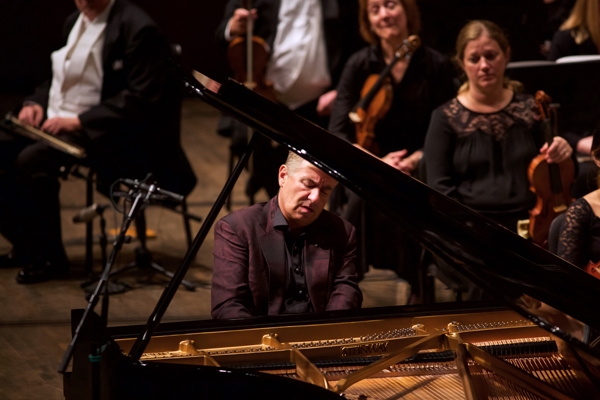The Grand Rapids Symphony Orchestra brought to life its second classical performance of the season on Friday night. The program’s main attraction was Aram Khachaturian’s Concerto for Piano in D-Flat Major, which promised a live musical saw and an impressive performance by acclaimed guest pianist Jean-Yves Thibaudet.
They both delivered.
Themed around “Scheherazade,” the program brought together three distinct pieces of different styles: Carl Maria von Weber’s brief, effervescent Overture to Abu Hassan; Khachaturian’s dramatic, frenzied Concerto featuring Thibaudet and the saw; and, of course, all four movements of Nikolai Rimsky-Korsakov’s epic, familiar Scheherazade.
Director Marcelo Lehninger enthusiastically kicked off the night with a playful, light performance of Weber’s Overture to Abu Hassan, which lasted just four minutes and set the tone well for a program that, while varied in style and primarily composed of 19th century romantic pieces, sounded like it would make a wonderful film score.
For the second piece of the evening, the orchestra was joined by pianist Thibaudet for the first time in its history. The first movement of Khatchaturian’s Concerto began on a sharp, strong note, with the pianist and the orchestra blending together to create a playful, jubilant mood and establish the theme that would weave throughout the piece for the next 33 minutes.
The piece quickly became a battle between soloist and orchestra. Thibaudet soared through impossibly quick, challenging variations without breaking his relaxed posture, pausing to watch Lehninger and the orchestra with delight when it was their turn to challenge him.
It was, without a doubt, Thibaudet who stole the show in the first movement, although the orchestra, led by a fiercely enthusiastic Lehninger, put up a formidable fight all the way to the movement’s dramatic conclusion.
In the second movement, the tables turned when the musical saw player entered the stage with two saws and a bow in hand. He took a seat to stage right of the piano, positioning himself to compete for the audience’s attention for the rest of the piece. The second movement, played andante con anima, began slowly and quietly, eventually swelling to give way to a lyrical melody played by the saw.
The audience was immediately enraptured by the mournful, quivering sound of the instrument, one that is not often seen in the United States but was a staple of folk and street music in Soviet Georgia, where the piece’s composer grew up.
The third movement, played allegro brillante, returned to the frenzied, competitive state of the first movement. This time it was the orchestra’s turn to shine — musical saw still included — featuring solos from the woodwind section as Thibaudet swayed along to their rhythms. He returned to the keys to play in unison with the orchestra leading up to an impassioned finish, where the Director turned to lock eyes with the soloist for the first time during the performance.
The two, who are friends, hugged immediately after the final note had rung out and received three rounds of standing ovation.
Thibaudet returned to the piano and announced he would to perform a solo encore of Ravel’s Pavane for a Dead Princess, which he promised would be peaceful, unlike the Concerto. The atmosphere of the performance hall changed immediately the moment his fingers hit the keys. The tension and fervor created by the last piece melted into a sweet, romantic 6-minute solo with just a hint of sadness. The crowd met the performance with yet another standing ovation, clearly sad to see the pianist go.
After the intermission, the orchestra treated the audience to a full 45-minute performance of Rimsky-Korsakov’s famous Scheherazade, a piece in four movements based on four of the stories from The Arabian Nights. The piece allowed for many opportunities for soloists to show off their own unique variations on Scheherazade’s many distinct yet similar themes.
The flute, the bassoon, the harp, the oboe, the brass section, and, of course, the lead violin (which is meant to represent the voice of Scheherazade herself) all shone brightly at various points throughout the orchestral suite. The final movement ended an emotional, dramatic performance on a quiet note, and the orchestra was met with yet another standing ovation.
The evening’s program ran for two hours including a 15 minute intermission.
The Symphony repeats the performance tonight at 8 pm at the DeVos Performance Hall.





